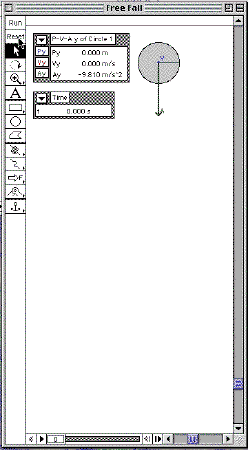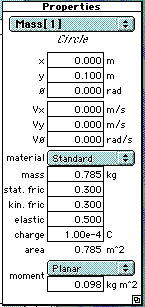AP Physics - Simulation 5
Free Fall
(uses Interactive PhysicsTM)
![[Prev]](../../NavIcons/Prev.GIF)
![[Next]](../../NavIcons/Next.GIF)


 [Lab Index]
[Lab Index]
BHS
-> Staff
-> Mr. Stanbrough ->
AP Physics -> Kinematics
-> this page
Free fall is probably the easiest situation to simulate using the
Interactive Physics program - all you do is create an object, and let
it go!
The Problem:
We will set up the simulation to solve the following problem:
A ball is dropped from rest and falls freely (no
air resistance) for 4.0 seconds. How far will it fall it this
time, and how fast will it be going after the 4.0 seconds has
elapsed?
The Simulation:
|
Here is a screen shot of the starting state of the
simulation.
|
|

|
|
The Properties Window for this simulation.
|

|
To set up this simulation:
- Open the Interactive Physics program.
- You might want to resize the window to make it taller and
thinner, but that's up to you.
- Set the accuracy
of the simulation to "Accurate".
- You can change the
acceleration of gravity to 10.0 m/s2 to make
checking the simulation's results easier, if you wish, but check
with your instructor first.
- Create a new
object - its size and shape doesn't matter.
- Open your
object's Properties Window and set:
- x = 0.0
- y = 0.0
- vx = 0.0
- vy = 0.0
- Create a Time
meter (clock).
- Create a P-V-A
meter (Y direction) for your object.
- Add a velocity
vector and an acceleration vector to your object.
Now, run the simulation. Watch the clock. When you get near 4.0
seconds, stop the simulation, and use the tape
player controls at the bottom of the screen to get to 4.0 seconds
exactly. Read the results from the P-V-A meter.
Some Additional Problems:
In the following problems, air resistance is to be neglected.
- What effect does changing
the mass of the object have on the results of the simulation?
Report your results.
- What effect does changing the size (select and drag a corner
with the mouse) of the object have on the results of the
simulation? Report your results. (You can find the area of the
object near the bottom of its Properties
Window.)
- An object is thrown downward with a speed of 5.0 m/s
(vy =
-5.0 m/s). How fast will it be going in 3.0 s? How far will it
have fallen? How is this related to the speed and displacement it
would have had if it had been released from rest? Explain your
results.
- A ball is thrown straignt upward with an initial speed of 15
m/s (vy
= 15 m/s). Where will it be in 4.0 s, and what will be its
velocity (speed and direction)?
- A ball is thrown straight upward with a starting speed of 30
m/s. Make a data table and record its acceleration, velocity and
position at 0.5 second intervals for 10.0 s. Construct
acceleration vs. time, velocity vs. time, and position vs. time
graphs for this motion. Use graph paper.
![[Prev]](../../NavIcons/Prev.GIF)
![[Next]](../../NavIcons/Next.GIF)


 [Lab Index]
BHS
-> Staff
-> Mr. Stanbrough ->
AP Physics -> Kinematics
-> this page
[Lab Index]
BHS
-> Staff
-> Mr. Stanbrough ->
AP Physics -> Kinematics
-> this page
last update June 15, 2000 by JL
Stanbrough


